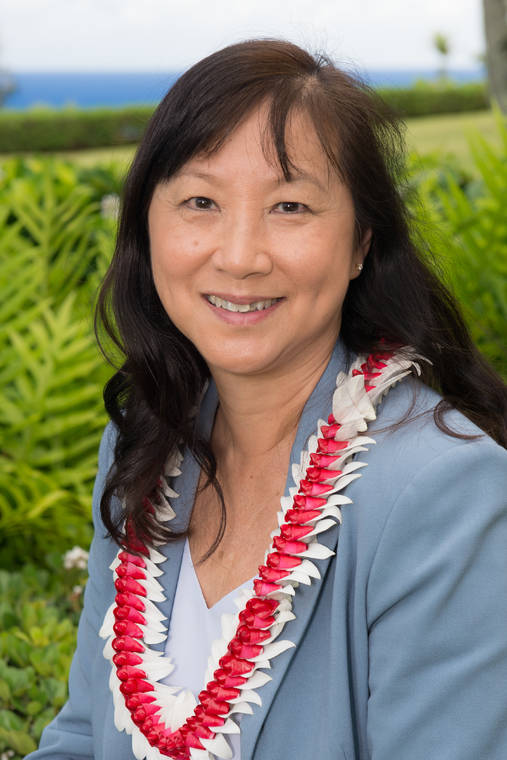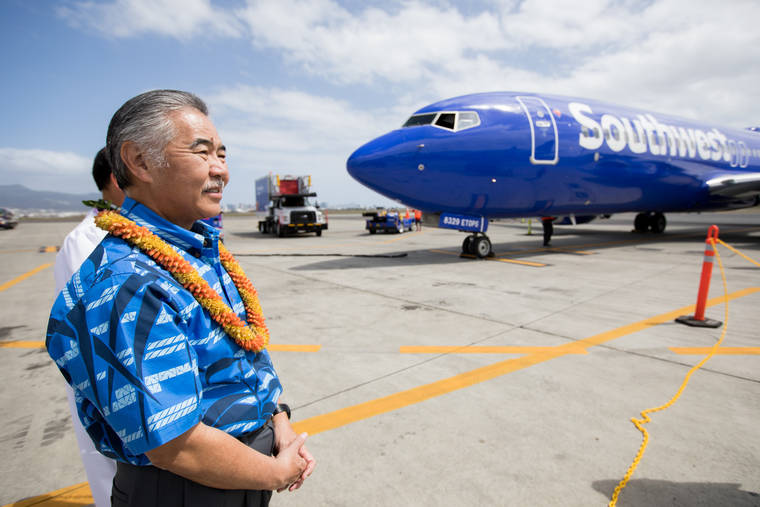Up in the air
LIHUE — Who is responsible for regulating the number of passenger flights that arrive on the island every day? That was one of the main questions brought up at a recent County Council meeting during a discussion of the Kauai Tourism Strategic Plan 2019-2021, which aims to mitigate the effects of “overtourism.”
The answer is the airline companies.
Additionally, under the “sovereignty and use of airspace” code, a citizen of the U.S. has a “public right of transit through the navigable airspace.”
Denise Wardlow, general manager of the Westin Princeville Ocean Resort Villas, who is playing an integral part in the strategic plan, said that, in their research, it was discovered that companies aren’t necessarily aligned with “us,” and few reach out to the community and take the impact of more arrivals on the island into consideration.
“It’s quite outrageous that people are making decisions without us,” said former mayor and councilmember JoAnn Yukimura during the meeting.
Nearly 1.4 million visitors arrived on Kauai last year, and more than 28,000 are on the island on any given day, according to statistics from the state Department of Business, Economic Development and Tourism.
The latter number is determined by a formula that takes into consideration length of stay, which has been increasing in the past few decades due to a rise in repeat inventory, such as condos, timeshares and transient vacation rentals, said Sue Kanoho of the Kauai Visitors Bureau.
Southwest Airlines is one company, however, that reached out to the community prior to determining their Kauai-bound flights, according to Brad Hawkins, senior adviser of communications for Southwest, who said community outreach efforts were orchestrated that consisted of meetings with people across the islands years before service started.
“We heard consistently across our conversations with locals of the hope and need for a competitive choice in interisland travel,” Hawkins said. “We have answered that in a relevant way that shows our commitment to the communities across the Islands, including Kauai County.”
And while Hawkins agreed that, within the U.S., it’s the carrier that “determines how frequently a market is served,” Southwest Airlines did make a concerted effort to connect with the community beforehand.
The company’s plan, as previously announced, is to have interisland service to and from Honolulu four times a day, each aircraft accommodating up to 175 passengers. Lihue is also expected to have one flight a day to and from either San Jose or Oakland, also with 175 seats, according to Hawkins.
When asked how Hawaiian Airlines determines the number of flights arriving on the island, Tara Shimooka, external communications manager at Hawaiian Airlines, provided a blog post from the company’s website. Among the elements the company takes into account, according to the post, are “reading the data” and “predicting the future,” primarily studying economic components.
“There is a multitude of factors that go into our decision to launch a new route, including market size, connectivity and demand, to name a few,” Shimooka said. “We’ve been serving the Kauai community for nearly 70 years, and have a strong sales presence locally.”
Hawaiian Air also co-hosts an annual luncheon with the Kauai Chamber of Commerce.
As of August, Hawaiian Airlines has 24 inbound interisland flights per day to Lihue, each with 128 seats, and two flights from the mainland every day, each with 189 seats, according to Shimooka.
The state Department of Transportation’s responsibility in these matters include coordinating gate and ticket counter availability with airlines for flight arrivals and departures. The DOT also works with airlines to manage other details like operations, but if an airline wants to start a new route, it “does not dictate the approval or denial,” according to the governor’s office.
Ways in which the state can step in to help with visitor impact, however, are through other actions, such as developing the new Haena State Park Master Plan.
“It is the first plan that envisioned reducing the number of visitors in an area. It’s a new system designed to protect the environment and community interests while supporting the visitor industry,” said Gov. David Ige.
“Clearly, too many people in a spot as beautiful as Haena is just not good for the environment and residents and visitors alike. The solutions aren’t easy, but the changes represent a chance to manage tourism more effectively.”
Ige also said that new flights aren’t just a product of market demand by visitors to the islands. It’s also about creating options for local residents to travel interisland or out of state.
“When Southwest Airlines entered the market, many local residents were excited because it brought pricing competition and more choices,” he said.
It’s possible, however, that flight demand could change as counties begin to look more closely at regulating short-term rentals, Ige said.
Curtailing illegal TVRs is one thing that the strategic plan addresses in its first year, whereby the team supports the county Planning Department’s efforts to identify and eliminate them.
“Hawaii is one of the most-dreamed-about destinations in the world,” Ige said. “Like other must-visit locations, we are considering ways to ensure that the environment and quality of life in our islands are preserved as more travelers are able to visit and experience the people, place and culture that make Hawaii unique.”
Alaska, American, United and Delta airlines, as well as Westjet, are other companies that operate on Kauai, according to the state’s Lihue Airport website.



‘ “It’s quite outrageous that people are making decisions without us,” said former mayor and councilmember JoAnn Yukimura during the meeting.’
By all means let’s grovel at the feet of Joann and her crones on the council for their permission to enjoy our right to unobstructed travel in this supposedly free country. And the freedom of a business like Hawaiian Airlines to provide the service.
What a series of really dumb questions. What determines how many flights to Kauai? Even a dope should know that it’s demand…you know, a response to reservations????
Unbelievable how many ignorant people are involved in this waste of time inquiry.
RG DeSoto
No Joanne, what is “OUTRAGEOUS ” is that the US Military industrial complex is illegally based here and every one of County, State and Federal workers now has no reason not to know that they are colluding and conspiring in War CRIMES against a Neutral independent government still in existence…. protected persons ARE ONLY those of us who want and work for PEACE, NOT POLITICIANS AND THEIR FAMILIES WHO ARE PILLAGING AND PLUNDERING OUR AINA.
READ THIS….. FOR FACTUAL NEWS.
HAWAIIANKINGDOM.ORG
Duh! Regulate the number of transient quarters (hotels, etc.) and you will have a say so. Hotels brings money, so I think people would not want to limit vacation housing.
28K tourists in Kauai each day? About 10K cars they’re driving each day.
Aloha Kakou,
1.) Visitors may spend much more time driving our roads than residents who only drive to the stores, jobs, and recreation.
2.) When visitors stay at large hotels, after the low wages are paid to locals, visitor money spent on the hotel rooms, “flies” back out with them to U.S. AND INTERNATIONAL BANKS. That money does not remain on Kaua’i nor is it circulated in the local economy. Visitor money goes bye bye with the visitors when they leave Kaua’i, same with rental car money.
3.) At the same time, everyone can see, even visitors, that the Kukui Grove and the super market shopping centers, and all local towns on Kaua’i have too many closed stores, empty, local businesses unable to remain in business. These are the very businesses that support local families, and local people with jobs, and provide restaurant local food, and diverse products for sale. And even the big department stores and Walmart their profits go off island as well.
4.) Local businesses are starving and the local people cannot support them.
5.) RESTRICTNG SHORT TERM VACATION RENTALS IS “SHOOTING US ALL IN THE FOOT…er…FEET…! ! !”
6.) Vacation rentals provide, often up to $200 per night…or $6,000 income per month…$72,000 per year. And taxes support the government and government workers and pensions.
7.) Vacation rental owners, like millions of other people already around the world, and more and more every day worldwide, earn incomes that send their kids to college, fix the truck, or buy a new one, add on a room, convert the carport to a living quarter, Pat doctor bills, buy property and build a house, open a business in one of the Empty stores or restaurants on Kauai, spend money at these local stores and restaurants (now closed) keeping them in business, employing more local people who who can work in them, in turn, allow the workers better wages, provide new good paying house keeping jobs, and employ handymen and women, as well as tradespeople, to fix or improve ones home. Think Termites, Dry Rot, and Rust
Vacation Rentals keep the money on Kaua’i for all of us and what local people want it spent on or intended for. Less income for locals leads to more local crime and drug people; so less Vacation Rentals means more chance of a “meth” or opiate den or dealer next door, instead of happy tourists from Colorado or Wisconsin or Switzerland who go exploring all day and early to bed instead of Locals up all night on drugs…and your lawn mower is not missing due to your Drug neighbor selling it for more…DRUGS…!
8.) If visitors make noise at night there are laws and police to enforce that. And landlords can add to rental agreements that if there are loud or late parties that they will be charged extra $1,000 to their credit card per days of neighbor disturbance. Possibly, vacation rental landlords, and maybe all landlords should be able to or made to have a rental clause that spells out the $1,000 a day noise or disturbance issue.
If the County thinks they can charge a vacation rental owner $10,000 a day, how about a property owner charging $1,000 a day to keep peace and quiet in the neighborhood, after all, it is visitors that need be kept in line not the owners.
9.) Residents that don’t like visitors are a minority on Kaua’i, and are what is called XENOPHOBIC…other same names are racists, ethnocentric, predjudice, mean, ignorant, or “self foot shooters”. We should not let the minority spoil the income ability ($72,000 a year in some cases) for local families.
In many countries small places like Kaua’i do not have hotels at all, all visitors stay with the local people and as a result the local Community thrive$ on the extra income $$$.
On Kauai If there is available street parking more Vacation Rentals should be allowed.
We all need the “money it’s what makes the world go round”.